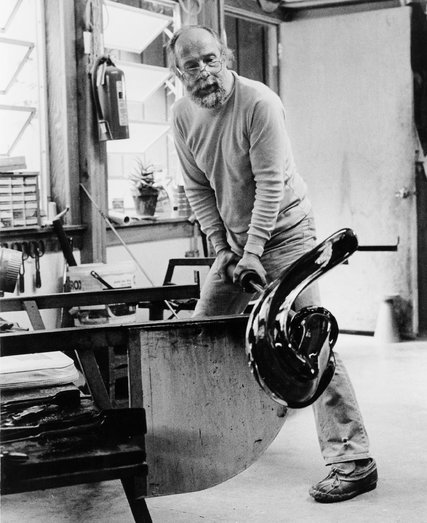
Article from Corning Museum website HARVEY K. LITTLETON AND THE AMERICAN STUDIO GLASS MOVEMENT, Published on October 18, 2011
Harvey Littleton is internationally acclaimed and recognized for his tireless work in founding and promoting the American Studio Glass movement. The movement was “born” in 1962, during two seminal glassblowing workshops at The Toledo Museum of Art. The workshops were led by Littleton, a Cranbrook-trained ceramist and professor at the University of Wisconsin at Madison, and Dominick Labino, a glass research scientist at the Johns-Manville plant near Toledo, Ohio. The aim of the workshops was to introduce artists to the use of hot glass as a material for contemporary art.
How did Littleton and Labino give artists access to glass? Although artists were already fusing glass in small studio kilns, hot glassworking techniques, such as glassblowing, moldblowing, and glass sculpting, required factory facilities. Littleton and Labino’s secret was a small furnace, which Labino helped to develop, and a low temperature melting-point glass, which Labino supplied. Littleton‘s impeccable organization and marshalling of funds, equipment, and artists, as well as his profound belief in the feasibility of studio glassblowing, insured the success of the workshops.
During the 1963 academic year, Littleton introduced the first university program for glass in the United States at the University of Wisconsin in Madison. The interest that he and his students generated in glass was immediate, and Littleton encouraged his graduating students to go out, find academic employment, and start more glass programs.
One of those students, studio glass pioneer Marvin Lipofsky, started glass programs at the University of California at Berkeley in 1964 and at the California College of Arts and Crafts in Oakland in 1967. Another student, the internationally known artist Dale Chihuly, went to study at the Rhode Island School of Design after leaving Madison. After graduating, he headed the glass department there, from 1969 to 1980. In a 1998 article on Harvey Littleton by William Warmus for GLASS Quarterly magazine , Dale Chihuly remembers:
Without a doubt, Harvey Littleton was the force behind the studio glass movement; without him my career wouldn’t exist. He pulled in talented students and visiting artists; I used the same concept when I taught [at the Rhode Island School of Design]. Also, Harvey was a big thinker—if he wanted a special piece of equipment, he would spend the money; he taught us to think big instead of thinking small. Some of that rubbed off on me. And he encouraged us to be unique—Harvey liked that.
With Littleton’s active encouragement and promotion, glass programs sprang up at universities, art schools, and summer programs across the country during the late 1960s and early 1970s. From the 1970s through the 1980s, the Studio Glass movement became an international phenomenon. What began nearly 50 years ago as a small group of artists who shared an unusual interest has grown into an international community of thousands.
For information on more available work from this artist, please contact us.